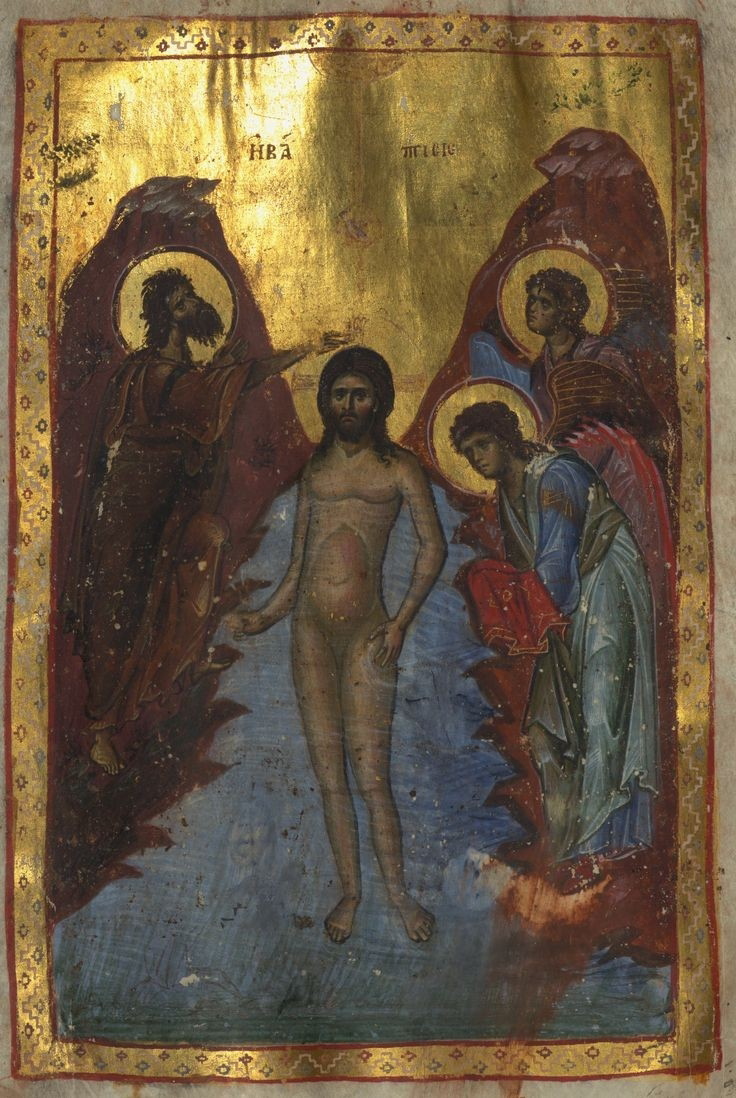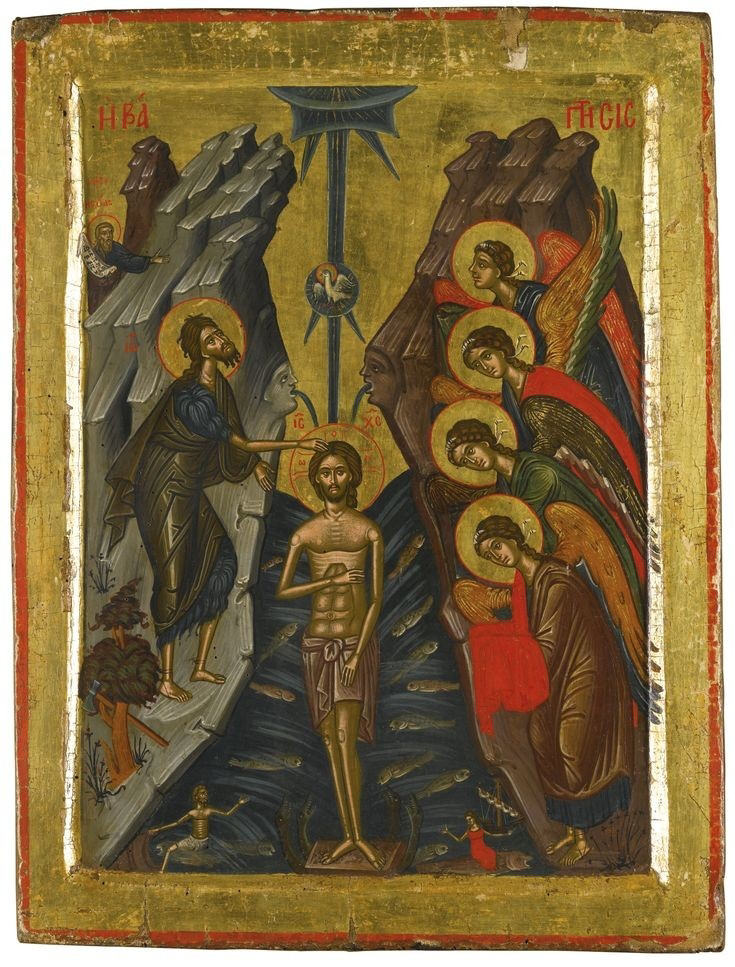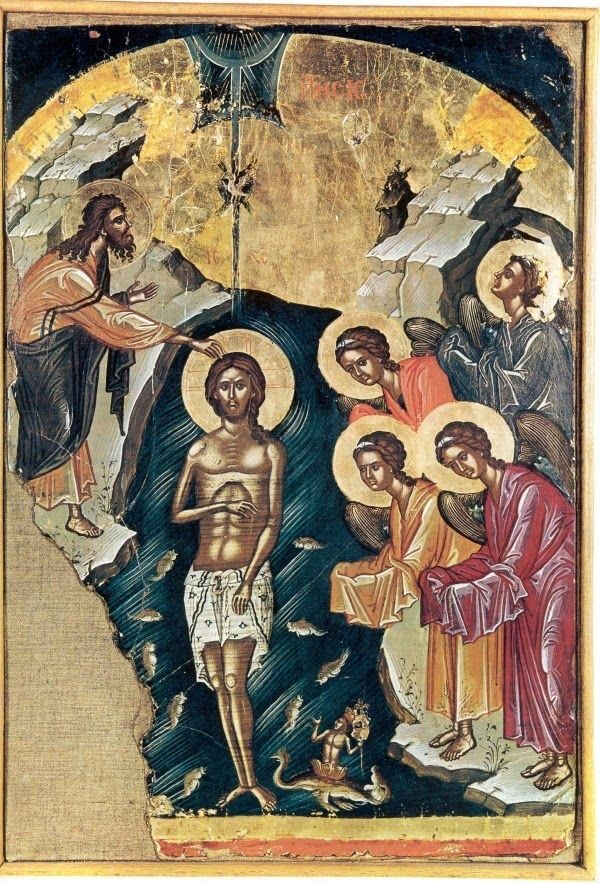Η ΒΑΠΤΙΣΗ ΤΟΥ ΚΥΡΙΟΥ (Τά Ἅγια Θεοφάνεια)
Ἡ Βάπτιση τοῦ Κυρίου φέρει τήν ὀνομασία Θεοφάνεια, γιατί κατά τη διάρκεια τῆς βάπτισης φανερώθηκε ή συμμετοχή τῶν Τριῶν Προσώπων τῆς Ἁγίας Τριάδας: Ὁ Θεός Πατέρας ἀποκαλύφθηκε μέ τόν λόγο Του, τό Ἅγιον Πνεῦμα-Θεός «ἐν εἴδει περιστερᾶς» εὐλογώντας τό ὕδωρ μέ τή σκιά του καί ὁ Υιός-Θεός, δεχόμενος το βάπτισμα τοῦ Ἰωάννου, ἁγιάζει τά ὕδατα. Το περιεχόμενο τῆς τριαδικότητας τῆς ἑορτῆς ἐκφράστηκε στο κοντάκιο τῶν Θεοφανείων καί καθορίζει τή μία τριαδική ἐνέργεια τῆς Θεότητας μέ μία καταπληκτική σαφήνεια.
«Ἐν Ἰορδάνη βαπτιζομένου σου, Κύριε, ἡ τῆς Τριάδος ἐφανερώθη προσκύνησις· τοῦ γάρ Γεννήτορος ή φωνή προσεμαρτύρει σοι, ἀγαπητόν σε Υἱόν ὀνομάζουσα˙ καί τό Πνεῦμα ἐν εἴδει περιστερᾶς, ἐβεβαίου τοῦ λόγου τό ἀσφαλές. Ὁ ἐπιφανείς, Χριστέ ὁ Θεός, καί τόν κόσμον φωτίσας, δόξα σοι».
Το βάπτισμα πού ἔδινε ὁ ἅγιος Ἰωάννης ἦταν βάπτισμα μετανοίας. Τό νερό τοῦ βαπτίσματος ἦταν νερό ἐξαγνισμοῦ, ἀπελευθέρωσης τοῦ ἀνθρώπου· ἕνα τέτοιο βάπτισμα δέν ἦταν ἀναγκαῖο γιά τόν Χριστό, γιατί ήταν προαιωνίως ἁγνός. Ἔλαβε ὅμως το βάπτισμα τοῦ Ἰωάννη ἀπό ταπεινοφροσύνη. Βαπτιζόμενος ὁ Ἰησοῦς δέν ἁγιάστηκε ἀπό τό ὕδωρ, ἀλλά τό ἀντίθετο, τό δεύτερο Πρόσωπο τῆς Τριάδας ἁγίασε τήν ὕλη τοῦ ὕδατος καί μαζί μ' αὐτό ὁλόκληρη τήν κτίση.
Μέ τό βάπτισμα τοῦ Ἰωάννη, τήν πράξη ὑπέρτατης ταπεινότητας τοῦ Χριστοῦ, ἀποκαλύπτεται ή Θεότητά Του ἀναπόσπαστο Πρόσωπο τοῦ Τριαδικοῦ Θεοῦ.
Ἡ Βάπτιση εἶναι τὸ σημεῖο τοῦ Χριστοῦ μέσα στόν κόσμο, σημεῖο ἐνάρξεως τῆς ᾿Αποστολῆς Του, ἡ καινούργια δημιουργία τοῦ φθαρτοῦ ἀπό τόν θάνατο τῆς πτώσης. Ἡ Βάπτιση είναι ἡ ἑορτή τῆς νέας δημιουργίας τοῦ κόσμου ὅπως καί μέ τή Γέννηση τοῦ Χριστοῦ, γι' αὐτό οἱ ἑορτές αὐτές εἶναι ἄρρηκτα δεμένες μεταξύ τους. Ἡ ἑορτή τῶν Χριστουγέννων δένεται συνεχῶς μέσα στά λειτουργικά κείμενα μέ τήν ἑορτή τῶν Θεοφανείων. Ἡ δομή τῶν ἀκολουθιῶν, κυρίως στον Ἑσπερινό τῶν Θεοφανείων, ἐπαναλαμβάνει σχεδόν καθ' ὁλοκληρίαν τά τροπάρια τῶν Χριστουγέννων, ἐκτός ἀπό μερικά στιχηρά πού ὑμνοῦν τήν ἑορτή τῶν Θεοφανείων σάν μιάν ἑορτή λαμπρότερη τῶν Χριστουγέννων.
Οἱ πατέρες τοῦ 4ου καί 5ου αἰώνα, ὅπως ὁ ἅγιος Ἀμβρόσιος Μεδιολάνων, ὁ ἅγιος Ἰωάννης ὁ Χρυσόστομος, ὁ ἅγιος Ἱερώνυμος ἐπισημαίνουν τήν ἐντελῶς διαφορετική Δόξα τῶν Θεοφανείων: «Μέ τή Γέννησή Του ὁ Υἱός τοῦ Θεοῦ φανερώθηκε στον κόσμο μ' ἕναν τρόπο μυστικό· στή Βάπτισή Του, ὅμως, φανερώθηκε μέ τρόπο ἀποκαλυπτικό» (Ἅγ. Ἱερώνυμος). Κατά τήν εὐαγγελική μαρτυρία ή Βάπτιση τοῦ Σωτήρα ἔγινε ὅταν ήταν περίπου τριάντα χρόνων, πράγμα πού συμπίπτει ἤ, ἀκριβέστερα, πλησιάζει τήν ἡμέρα τῆς Γεννήσεως. Κι ἐδῶ βρίσκεται ὁ ἐσωτερικός δεσμός τῶν ἱερῶν γεγονότων· ξεδιπλώνεται θά 'λεγε κανείς τό χρυσό νῆμα πού συνδέει τα Χριστούγεννα μέ τά Θεοφάνεια. Στή ρωμαιοκαθολική Εκκλησία τό διάστημα μεταξύ τῶν δύο ἑορτῶν εἶναι μεγαλύτερο ἀπό ὅ,τι στήν Ὀρθόδοξη Ἐκκλησία· ὁ δεσμός ὅμως τῶν δύο ἑορτῶν μένει ὁ ἴδιος. Ἡ ἀρμενική Ἐκκλησία διατηρεῖ τήν ἀρχαία σηνήθεια νά ἑορτάζει τή Γέννηση καί τή Βάπτιση τοῦ Χριστοῦ τήν ἴδια ἡμέρα: 25 Δεκεμβρίου.
Ἡ ἑορτή τῶν Θεοφανείων φέρει τ' ὄνομα τῆς ἑορτῆς τῶν Φώτων, ἑορτή τοῦ Φωτός. Τούς πρώτους χριστιανικούς αἰῶνες οἱ κατηχούμενοι ἐλάμβαναν το βάπτισμα ἐκείνη ἀκριβῶς τήν ἡμέρα, ἀνάμεσα σ' ἕνα μεγάλο αριθμό ἀναμμένων λαμπάδων αὐτό γινόταν γιατί ὅπου ὁ Θεός, ἐκεῖ καί τό Φῶς, ἀφοῦ «ὁ Θεός φῶς ἐστίν». Μέσα σ' αὐτή τήν ἑορτή ὁ σαπισμένος κόσμος ἀναδημιουργεῖται μυστηριακά κι ὅπως στη δημιουργία τοῦ κόσμου, ἔτσι κι ἐδῶ ὁ Θεός ἀγγίζει, ἐξαγνίζει καί ζωοποιεῖ τήν οὐσία τοῦ ὕδατος. Μπαίνει μέσα στο νερό ὁ Χριστός γιά νά τό καθαρίσει, νά τό ζωοποιήσει, νά τό ἁγιάσει καί νά καταπατήσει τα φίδια πού φωλιάζουν ἐκεῖ. Τό Ἅγιο Πνεῦμα, «ὡσεί περιστερά» καλύπτει τά ὕδατα, ὅπως καί στή δημιουργία τοῦ κόσμου ὅπου «ἐπεφέρετο ἐπάνω τοῦ ὕδατος». Κατά τήν ἑρμηνεία τοῦ Μεγάλου Βασιλείου, ὄχι μόνον ἐπεφέρετο πάνω ἀπό τά ὕδατα, ἀλλά ἔμοιαζε να μεταδίδει στο νερό τήν ἰδιότητα τῆς ζωτικῆς δύναμης, καθιστούσε δηλαδή τό νερό φορέα ζωτικῆς δύναμης, τό ζέσταινε ὅπως ζεσταίνουν τά πετεινά τοῦ οὐρανοῦ τά αὐγά τους καί δίδουν ζωή στά μικρά νεογνά τους.
Ἐδῶ τὸ Πνεῦμα τὸ Ἅγιο μεταδίδει στά ὕδατα τή χάρη καί τήν δύναμη πού γεννᾶ τή ζωή μέσα στο μυστήριο τοῦ Βαπτίσματος γίνεται ὕδωρ πού ἀναπηδᾶ στήν αἰώνια ζωή.
Σάν ἀρχέτυπο ή περιστερά τῆς Κιβωτοῦ, πού ἄφησε ὁ Νῶε ἐλεύθερη καί ἐπέστρεψε μ' ἕναν κλῶνο ἐλιᾶς στό ράμφος της, προεικονίζει τό Ἅγιο Πνεῦμα τῶν Θεοφανείων πάνω ἀπό τά ὕδατα τοῦ Ἰορδάνη. Ὁ ἅγιος Ἰωάννης ὁ Χρυσόστομος ἐξηγεῖ τήν εἰκόνα τῆς «περιστερᾶς» πού πῆρε τό Ἅγιο Πνεῦμα στά Θεοφάνεια: Λαμβάνοντας ἀπό τό χέρι τοῦ ἁγίου Ἰωάννου τό βάπτισμα, ὁ Χριστός ἦρθε «πληρώσαι πᾶσαν δικαιοσύνην». Δικαιοσύνη ὀνομάζουμε τήν ἐκπλήρωση ὅλων τῶν ἐντολῶν. Ὁ Χριστός εἶναι ὁ μόνος πού ἐκπλήρωσε αὐτή τή δικαιοσύνη μέ τόν ἐρχομό του. Ἔτσι, ἄν ἡ ὑποταγή στόν Θεό συνιστᾶ τήν ἀλήθεια κι ὁ Θεός ἔστειλε τόν ἅγιο Ιωάννη γιά νά βαπτίσει τό λαό, τότε ὁ Χριστός ἐκπλήρωσε κι αὐτό ἀκόμα. Ἡ γενεά μας ὤφειλε να πληρώσει τό χρέος της, ὅμως δέν τό πλήρωσε κι ὁ θάνατος μᾶς ἀγκάλιασε ὅλους ἐμᾶς πού εἴμασταν ὑποταγμένοι σ' αὐτό τό λάθος. Ὁ Χριστός ἐρχόμενος μᾶς βρῆκε στα χέρια τοῦ διαβόλου καί πλήρωσε αὐτό τό χρέος. «Σέ μένα πού ἔχω, ταιριάζει να πληρώσω γι' αὐτούς πού δέν ἔχουν» λέει. Αὐτή εἶναι ἡ αἰτία τοῦ Βαπτίσματός Του. Γι' αὐτό τό λόγο τό Πνεῦμα κατέβηκε ἐν εἴδει περιστερᾶς γιατί ὅπου ὑπάρχει συμφιλίωση μέ τόν Θεό, ἐκεῖ εἶναι ἡ περιστερά, ὅπως καί μέ τό Νώε, ὅπου ἡ περιστερά μέ τό κλωνάρι ἐλιᾶς ἦταν δεῖγμα τῆς ἀγάπης τοῦ Θεοῦ γιά τόν ἄνθρωπο· τό τέλος τοῦ κατακλυσμοῦ. Ἔτσι κι ἐδῶ, μέ τή μορφή περιστερᾶς κι ὄχι σώματος (καί πρέπει νά ὑπογραμμιστεῖ αὐτό) τό πνεῦμα κατέβηκε άναγγέλοντας τή θεία Χάρη σ' ὁλόκληρο τό σύμπαν.
Πηγή:
ΣΗΜΕΙΩΣΕΙΣ ΕΝΟΣ ΕΙΚΟΝΟΓΡΑΦΟΥ .
Π.Γρηγορίου Κρούγκ. Εκδοσεις Παναγόπουλου
Μεταφραση Σπυριδωνος Μαρίνη
The Baptism of the Lord (The Holy Theophany)
The Baptism of the Lord is called Theophany because, during His baptism, the participation of the three Persons of the Holy Trinity was revealed: God the Father manifested through His voice, the Holy Spirit appeared "in the form of a dove" blessing the water through its shadow, and the Son of God, by receiving the baptism of John, sanctified the waters. The trinitarian nature of this feast is clearly expressed in the kontakion of Theophany, which outlines the singular triune action of the Godhead with remarkable clarity:
"When You were baptized in the Jordan, O Lord, the worship of the Trinity was revealed; for the voice of the Father bore witness to You, calling You His beloved Son, and the Spirit, in the form of a dove, confirmed the truth of the word. O Christ God, who has appeared and enlightened the world, glory to You."
The baptism performed by St. John was a baptism of repentance. Its water symbolized purification and liberation for humanity. Such a baptism was unnecessary for Christ, as He was eternally pure. Yet, He received John's baptism out of humility. When Jesus was baptized, He was not sanctified by the water; instead, the second Person of the Trinity sanctified the water itself and, along with it, all of creation.
Through the baptism of John, an act of supreme humility by Christ, His divinity as an integral Person of the Triune God was revealed.
The Baptism marks Christ's entrance into the world and the beginning of His mission. It signifies the new creation, redeeming the mortal world from the death of sin. The Baptism is the feast of the new creation of the world, intimately connected with the Nativity of Christ. For this reason, these two feasts are inseparably linked. The feast of Christmas is constantly intertwined with that of Theophany in the liturgical texts. The structure of the services, especially during the Vespers of Theophany, repeats nearly all the hymns of Christmas, with only a few verses specifically exalting Theophany as an even greater celebration than Christmas.
The Fathers of the 4th and 5th centuries, such as St. Ambrose of Milan, St. John Chrysostom, and St. Jerome, emphasized the distinct glory of Theophany: "Through His birth, the Son of God was revealed to the world in a hidden way; through His baptism, however, He was revealed openly and manifestly" (St. Jerome). According to the Gospel account, the Savior's baptism occurred when He was about thirty years old, coinciding with or closely following His birthday. Here lies the intrinsic connection between these sacred events—the golden thread that binds Christmas to Theophany. In the Roman Catholic Church, the interval between these two feasts is longer than in the Orthodox Church; however, the bond between them remains the same. The Armenian Church preserves the ancient tradition of celebrating Christ's Birth and Baptism on the same day, December 25th.
The feast of Theophany is also known as the Feast of Lights, a celebration of divine light. In the early Christian centuries, catechumens received baptism on this very day amidst a multitude of lit candles, signifying that where God is present, there is light, for "God is light." Through this feast, the corrupt world is mystically recreated, and just as in the creation of the world, so here too, God touches, purifies, and animates the essence of water. Christ enters the waters to cleanse, revive, sanctify them, and trample upon the serpents that dwell within them. The Holy Spirit, "in the form of a dove," hovers over the waters, as it did during the world's creation when it "moved over the face of the waters." According to St. Basil the Great, the Spirit not only hovered over the waters but seemed to transmit to them the property of vital force, making water a bearer of life-giving power, warming it as birds warm their eggs to give life to their young.
Here, the Holy Spirit imparts grace and the life-giving power to the waters, transforming them into the "water springing up to eternal life" in the mystery of Baptism.
Like the dove released by Noah from the Ark, which returned with an olive branch in its beak, foreshadowing the Holy Spirit's appearance over the waters of the Jordan, the Spirit at Theophany bears witness to God's love for humanity. St. John Chrysostom interprets the image of the "dove" taken by the Holy Spirit at Theophany: Receiving baptism at the hands of St. John, Christ came to "fulfill all righteousness." Righteousness is the fulfillment of all commandments, and Christ is the only One who fulfilled this righteousness by His coming. Thus, if submission to God constitutes truth and God sent St. John to baptize the people, then Christ fulfilled even this. Humanity owed a debt it could not pay, and death enveloped all of us who were subjected to sin. Christ came and found us in the devil's grasp and paid this debt. "It is fitting for Me, who possesses, to pay for those who do not," He said. This is the reason for His Baptism. For this reason, the Spirit descended in the form of a dove because where reconciliation with God is found, there is the dove, just as with Noah, where the dove with the olive branch was a sign of God's love for humanity and the end of the flood. So here too, in the form of a dove—not a body (a distinction that must be emphasized)—the Spirit descended, proclaiming divine grace to the entire universe.
Source:
NOTES OF AN IKONOGRAPHER.
Fr. Gregory Krug. Panagopoulos Publications.
Translation by Spyridon Marinis









Δεν υπάρχουν σχόλια:
Δημοσίευση σχολίου